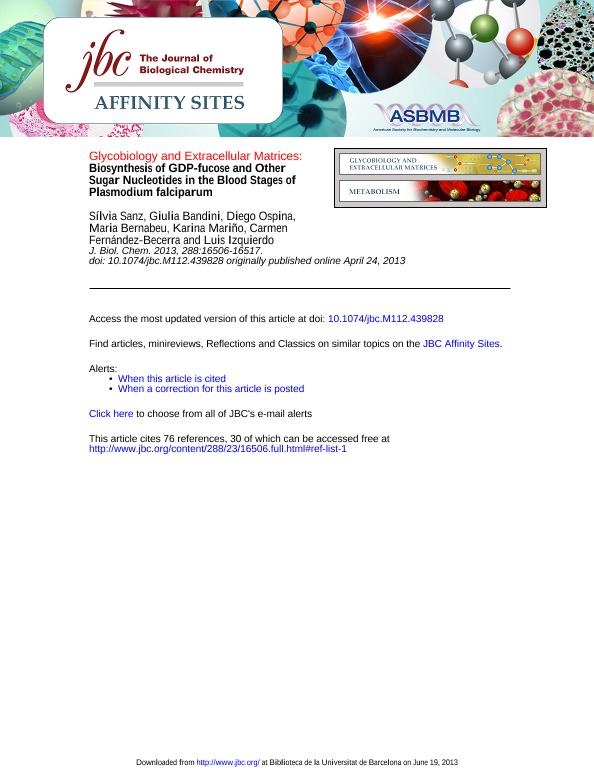Artículo
Biosynthesis of GDP-fucose and other sugar nucleotides in the blood-stages of Plasmodium falciparum
Sanz, Silvia; Bandini, Giulia; Ospina, Diego; Bernabeu, Maria; Mariño, Karina Valeria ; Fernández Becerra, Carmen; Izquierdo, Luis
; Fernández Becerra, Carmen; Izquierdo, Luis
 ; Fernández Becerra, Carmen; Izquierdo, Luis
; Fernández Becerra, Carmen; Izquierdo, Luis
Fecha de publicación:
07/06/2013
Editorial:
American Society for Biochemistry and Molecular Biology
Revista:
Journal of Biological Chemistry (online)
ISSN:
0021-9258
e-ISSN:
1083-351X
Idioma:
Inglés
Tipo de recurso:
Artículo publicado
Clasificación temática:
Resumen
Carbohydrate structures play important roles in many biological processes, including cell adhesion, cell-cell communication, and host-pathogen interactions. Sugar nucleotides are activated forms of sugars used by the cell as donors for most glycosylation reactions. Using a liquid chromatography-tandem mass spectrometry- based method, we identified and quantified the pools of UDP-glucose, UDP-galactose, UDP-N-acetylglucosamine, GDP-mannose, and GDP-fucose in Plasmodium falciparum intraerythrocytic life stages. We assembled these data with the in silico functional reconstruction of the parasite metabolic pathways obtained from the P. falciparum annotated genome, exposing new active biosynthetic routes crucial for further glycosylation reactions. Fucose is a sugar present in glycoconjugates often associated with recognition and adhesion events. Thus, the GDP-fucose precursor is essential in a wide variety of organisms. P. falciparum presents homologues of GDP-mannose 4,6-dehydratase and GDP-L-fucose synthase enzymes that are active in vitro, indicating that most GDP-fucose is formed by a de novo pathway that involves the bioconversion of GDP-mannose. Homologues for enzymes involved in a fucose salvage pathway are apparently absent in the P. falciparum genome. This is in agreement with in vivo metabolic labeling experiments showing that fucose is not significantly incorporated by the parasite. Fluorescence microscopy of epitope-tagged versions of P. falciparum GDP-mannose 4,6-dehydratase and GDP-L-fucose synthase expressed in transgenic 3D7 parasites shows that these enzymes localize in the cytoplasm of P. falciparum during the intraerythrocytic developmental cycle. Although the function of fucose in the parasite is not known, the presence of GDPfucose suggests that the metabolite may be used for further fucosylation reactions.
Palabras clave:
Sugar Nucleotides
,
Malaria
,
Plasmodium Falciparum
,
Glycobiology
Archivos asociados
Licencia
Identificadores
Colecciones
Articulos(IBYME)
Articulos de INST.DE BIOLOGIA Y MEDICINA EXPERIMENTAL (I)
Articulos de INST.DE BIOLOGIA Y MEDICINA EXPERIMENTAL (I)
Citación
Sanz, Silvia; Bandini, Giulia; Ospina, Diego; Bernabeu, Maria; Mariño, Karina Valeria; et al.; Biosynthesis of GDP-fucose and other sugar nucleotides in the blood-stages of Plasmodium falciparum; American Society for Biochemistry and Molecular Biology; Journal of Biological Chemistry (online); 288; 23; 7-6-2013; 16506-16517
Compartir
Altmétricas



